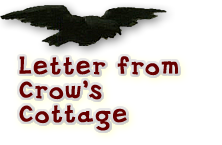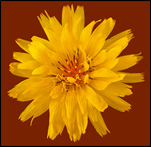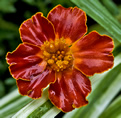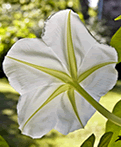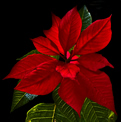
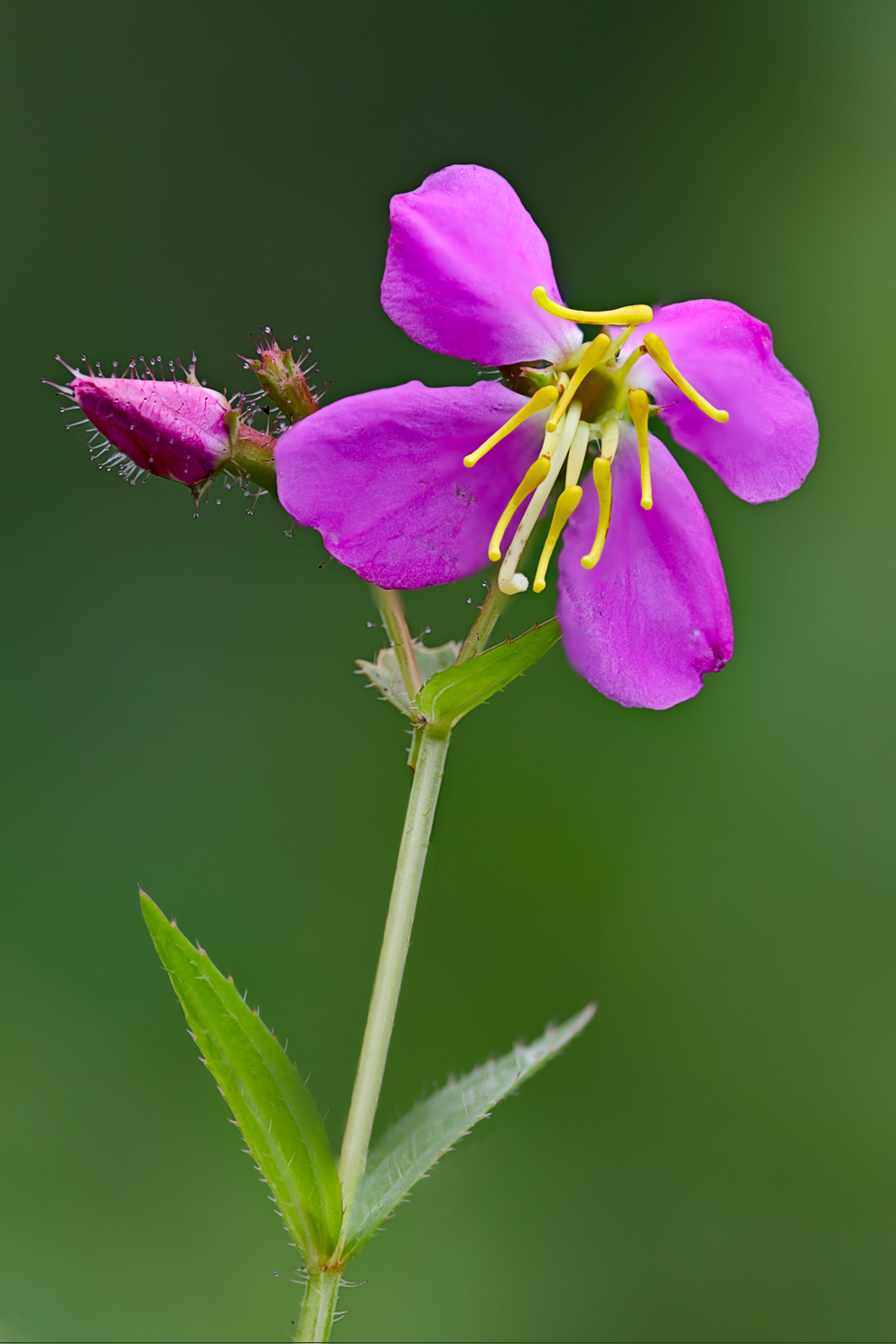
Thoreau's Cream Pitcher Is My Meadow Beauty.
∞
Rhexia virginica
In a wet meadow adjacent to a swamp in Amherst, Massachusetts | 6 August 2011
Photograph by Stephen Gingold
Photographer's Note:
9 images with a 180mm macro lens @f/5.6 stacked in Photoshop
to retain maximum detail and isolate the flower against what had been a busy background.
By Ebenezer Baldwin Bowles
Posted on 11 September 2013 from rural Washington County, Arkansas
Perception yields the mystery. What do we see with open eyes? The first look, the second, and then a third reveal different aspects of a thing. The parade of the moment is constant, dependable, moveable — presenting scenes of simple joy and connected revelation. But what to do after the parade passes and I'm not willing to let go?
Stephen Gingold's elegant image of the Meadow Beauty — he spied the specimen on a wet Massachusetts landscape a few years back — caught my eye this summer when it appeared as a sudden delight on my Google+ stream. Admiring the yellow and violet colors and droopy form of the flower, I paused to recall the day I met my Meadow Beauty and the subsequent discovery, a year later, that the ancient wildflower is a cream pitcher, too.
Unwrapping so many layers of memory.…
An afternoon in Delaware, late summer of 2009, when I photographed a flower I couldn't identify.…
A night in early spring two seasons later when I discovered the flower's identity in my study here at the cottage.…
And then wrote about it.…
Stephen's image, three-and-a-half years later, scrolling onto the social-net scene at Google+.…
Knowledge of the Meadow Beauty's allure to observers of nature from Thoreau all the way back to Pliny the Elder.…
And now it's a new day in the autum of 2013.… I asked, and Stephen agreed to allow the publication of his image here on the Glossary and Compendium, providing me sufficient reason to revisit my original photo essay — and shape it anew.
Yes, it is a cream pitcher, that glorious little wildflower, the one I saw a' swayin' in the warm breeze beside a backcountry lane in the south of Delaware. But when I encountered it, I was caught up in the graceful swirls of the petals, the sweeping cylinders of the golden anthers, and didn't see the domestic metaphor embedded in the picture — not until an evening some months later in the solitude of Crow's Cottage when the cream pitcher revealed its form. Even then, it required the intervention of Henry David Thoreau to open my drowsy eyes.
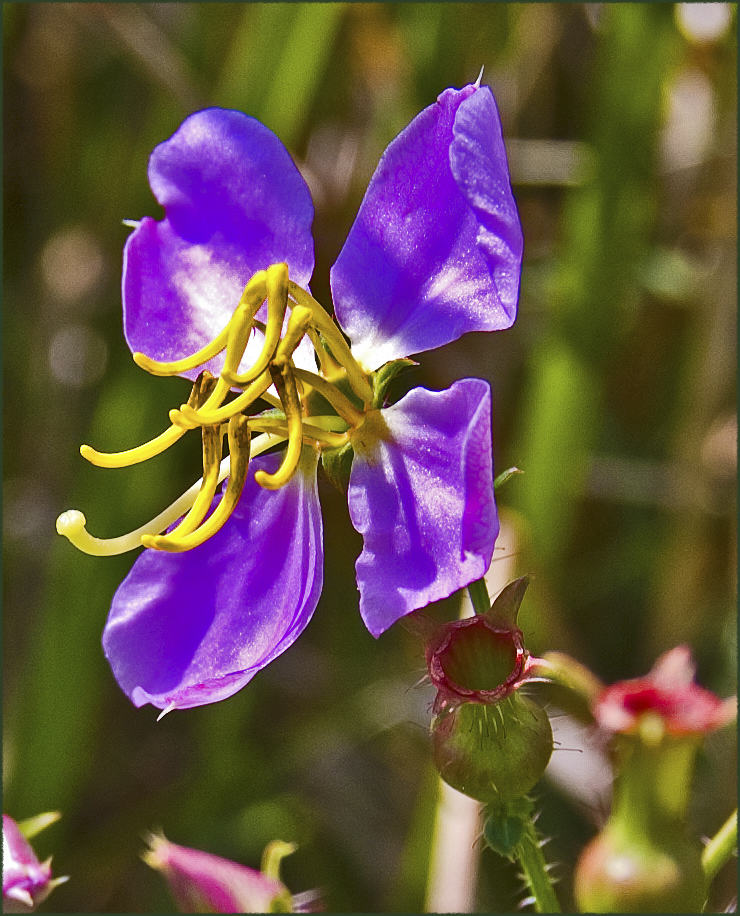
'Perfect Little Cream Pitchers'
Samuel Hill Road in the south of Delaware • August 20, 2009
This is the lead photograph for my original essay.
Thoreau's cream pitcher is easy enough to detect
with its red rim and green, bulbous body.
If only I'd known! I cudda zeroed-in on the pitcher.
The blurry object in the background, bottom right,
also depicts the shape of a pitcher.
Dancing in the Wind
"The scarlet leaves and stem of the rhexia, some time out of flower, make almost as bright a patch in the meadow now as the flowers did. Its seed vessels are perfect little cream pitchers of graceful form," Thoreau wrote on October 2, 1856.
Cream pitcher? Focused on the bloom, I missed the seed vessel. The striking purple petals of the Meadow Beauty drew my gaze like a beacon on the waters of nearby Chesapeake Bay might draw the attention of a ship's captain at the midnight helm. Too, the act of field photography — especially when the subject is a tiny flower, dancing in the wind and refusing to stay still for her portrait — demands intense attention to mechanical detail and aesthetic intent. My Google+ friend Stephen does it much, much better.
Zen sometimes fails me in these situations, where the possibilities of the moment must be filtered by necessity into a finite set of intended positive outcomes. It is way easy to mess up, or miss something on location that later appears as a fuzzy lost opportunity, painfully obvious in retrospect, after the image is opened and studied on a computer screen far, far away from the place of origin.
The philosopher Thoreau was contemplating his field of flowers at season's end, when the petals had fallen to fodder, and the yellow and carmine of the maturing pods had darkened into olive and scarlet vessels, ripe for the release of seeds. In the image a few paragraphs above this 'un, the cream-pitcher metaphor is visible in two aspects — one sharply focused and shown from above as we peer into an open mouth, the other blurry and demanding much imagination to show the tuber handle and elongated vegetable body of the receptacle. I've taken the same image and altered it again in the vain attempt to depict the pitcher. It's directly below — the best I can muster, given the lateness of the hour and the thousand miles between me and the remembered moment. I can't go back there no more not again ever.
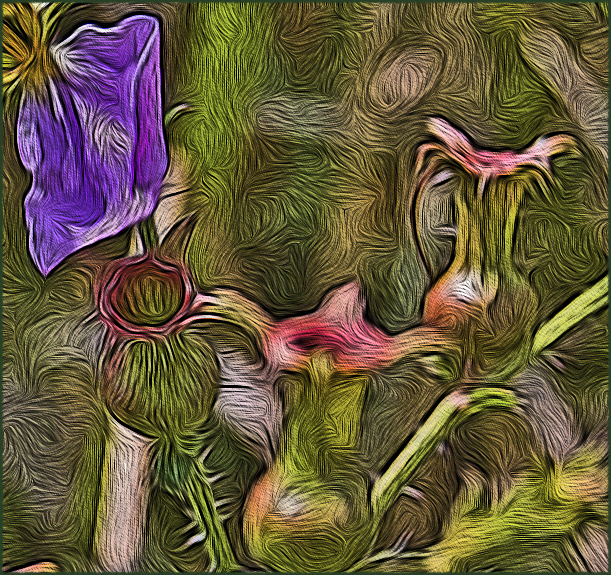
Rhexia, Thoreau's first-mention of the Meadow Beauty, alludes to the genus of the flower and by inference to the practice of employing ancient languages to formally identify plants and animals. The macrocosmic downward spiral from kingdom through phylum, class, order, family, and genus carries us, ultimately and singularly, to the name of the species, signifying the end of a charted journey of scientific precision and intellectual beauty.
Plante →
Magnoliophyta →
Magnoliopside →
Myrtales →
Melastomataceae →
Rhexia virginica
A Little Red Chalice
Then we have the common name of the thing, the fun part of the naming game, where local color and casual imprecision replace the rigor of taxonomy. My Meadow Beauty could just as well be your Handsome Harry or Virginia Meadowbeauty. Thoreau, ever lyrical, called his "little cream pitchers" by another name, "little reddish chalices," in his journal entry of September 14, 1851, and also referred to the flower as "Deer Grass." In honor of Thoreau, I surmise, the gorgeous little perennial is also commonly known by the name Meadow Pitcher.
Follow the word rhexia along the arcane path of etymology and you'll find reference to broken asunder, rent, rupture, burst forth. By adjusting the path to follow the guideposts of inference and digression, you may arrive in ancient Greece. I did, and there I found the word rhegmymi, leading at the end to the English word earthenware. Thoreau's metaphor of meadow pitcher is confirmed in the laboratory of Crow's Cottage.
The Meadow Beauty is an old favorite of the earthen landscape, having appeared one thousand, nine hundred and thirty-three years ago (AD 77) under the name rhexia in the works of Roman natural philosopher Pliny the Elder, who wrote in his Natural History [Book XX, Entry XXV: William Heinemann, London; 1949-54]:
There is another plant also, the proper name of which is onochilon, called by some people anchusa, or archebion, or onochelis, or rhexia, and by many enchrysa. It has a short base, a purple flower, rough leaves and branches, a root blood-red at harvest time, though dark at other times, growing on sandy soils, an antidote to the bites of serpents, especially of vipers, both root and leaves being equally efficacious in food and in drink.
Want to avoid snake bites? Put a Meadow Beauty in your pocket whenever you venture into snake territory and you shall never be bitten, Pliny advises. Romans also applied the root of the rhexia to freckles and leprous sores. They drank its renderings with hyssop to drive out tapeworms.
My Meadow Beauty grew on farmland among others of its kin in the southern Delaware backcountry along Samuel Hill Road, a few hundred yards from where it intersects Laurel Road, a named stretch of State Highway 24. Trap Pond State Park is close by. The diameter of the bloom from petal to petal is not much more than one inch. In its natural environment, clinging to moist and sandy soil, the Meadow Beauty appears frail and tiny. Here on the backpages of Crow's Cottage, frozen in an instant of light, motionless on a pixilated field, with the afternoon sun casting shadows of anthers on the shimmering surface of the blooms, my Meadow Beauty — Stephen's, too — becomes the mystery of perception.
∞
Mysteries of Perception was posted on Wednesday, September 11, 2013
![]() Stephen Gingold Nature Photography
Stephen Gingold Nature Photography
Crow's Cottage was very pleased when Stephen agreed to collaborate on our Meadow Beauty feature. Based in Amherst, Masachusetts, Stephen passionately ascribes to a natural history philisophy inspired by the wonders of diversity in nature and grounded in the complexities of ecology. His web includes galleries of waterfalls and streams, butterflies and moths, flora and fauna, and the landscapes of woods, meadow, and water. It's a visual treat of original beauty.
![]() Stephen Gingold Nature Photography Blog
Stephen Gingold Nature Photography Blog
Featuring commentary related to images of nature from western New England, Stephen's WordPress blog, launched in May 2010, combines backcountry travel logs, photo tips, and natural history into a very good read.
![]() Delaware Wildflowers
Delaware Wildflowers
When I sought help to find the name of the little bloom that became my Meadow Beauty, I turned to David Smith, master of the website Delaware Wildflowers, who knew in an instant the little flower's identity, which he graciously shared via e-mail. David's Delaware Wildflowers is a free, open, non-commercial, and original place devoted to the sharing of knowledge and experience. David's web is a beautiful piece of work by an individual who found a vision and mustered the will to pursue it.
![]() Lady Bird Johnson Wildflower Center
Lady Bird Johnson Wildflower Center
For clarity of expression tinged with an occasional splash of elegance, the text provided by the Lady Bird Johnson Wildflower Center is well worth the reading. An outreach of the University of Texas at Austin, the Lady Bird Center's web shows what corporate financial power can accomplish when shorn of commercialism and the cookie-cutter commonplace.
![]() An Easy Puzzle: Shade Drenched, Flat and Tidy
An Easy Puzzle: Shade Drenched, Flat and Tidy
A meditation on Southern Delaware . . . ripe corn on a roadside stalk . . .
historic Bethesda Church . . . the Meadow Beauty before I knew its name.



